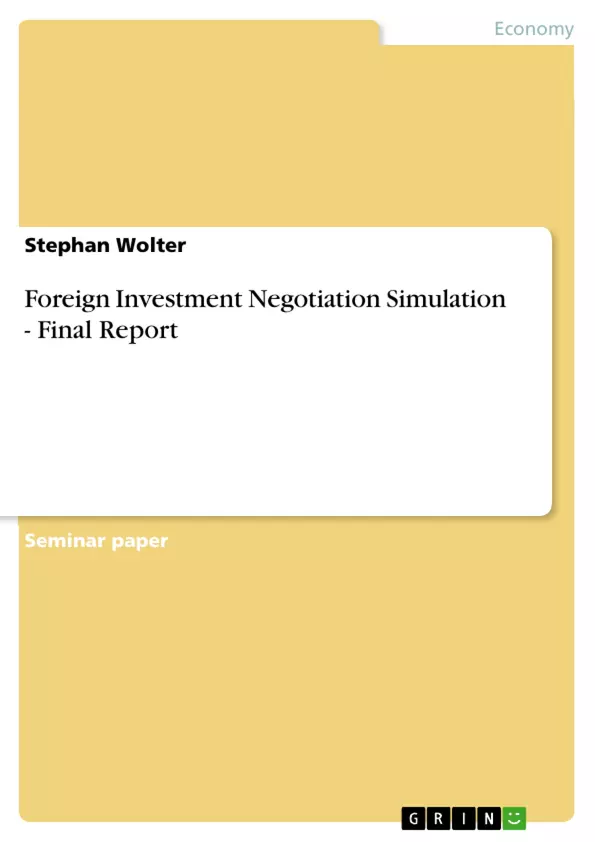"WTO REACHED AGREEMENT for talks on a global trade deal.
A seven-year struggle ended in Qatar when delegates put together a trade-liberalization agenda to open markets between rich and poor nations. If ensuing negotiations are successful, companies from wealthy nations would get better access to markets in poor nations, which in turn would receive greater foreign investment….."
This and other articles with such a statement appear in great number in today's daily press. The trend is given by globalisation and free trade. The spread of market based economic systems, trade agreements like the General Agreement on Tariffs and Trade (GATT), institutions like the World Trade Organisation (WTO) and a better cultural understanding, push the boundaries of bargaining and trading far beyond the borders of an individual country.
Multinational Companies (MNC) are dominating the Fortune and Global 500. Their economies are comparable to those of countries'. They offer thousands of workplaces and represent a phenomenon in strategy and structure, which is thoroughly investigated by economic and business researchers: Why do MNCs emerge? How do they go abroad? What strategies and structures can be found? In what way do MNCs differ to domestic firms? How can emerging complexity be handled? These are only some of the questions, which have to be answered.
The key point is to utilize the absolute advantages, the comparative advantage, or the 'diamond', which are offered by special countries, and thus gain competitive advantage for the company. The attractiveness of a country is determined by its market size, education and living standards, costs, political, legal and economical risks, long-run benefits, ethnical issues and cultural factors. It makes sense to disperse a firms value chain activities to those places where they can be performed most efficiency or where they have the greatest value for the company. Therefore a company can go abroad to invest in foreign countries.
Inhaltsverzeichnis (Table of Contents)
- Introduction
- FINS
- Features
- Players
- Foreign Market
- Product
- Strategy
- Goal/strategy/tactics-pyramid
- Global Strategy
- Negotiation History
- Progression
- Strategy changes
- Evaluation
- Progression and way of negotiation
- Agreements
- Future outlook
- Personal comments
- Learning experience
- Criticism
- Ending remarks
- Appendix
Zielsetzung und Themenschwerpunkte (Objectives and Key Themes)
This report aims to provide an analysis of the FINS Foreign Investment Negotiation Simulation, focusing on the negotiations conducted by Megatronics Inc. The report explores the company's strategic choices, negotiation strategies, and the resulting outcomes, providing an in-depth understanding of the complexities of foreign investment and international business.
- International Business Strategies and Foreign Investment
- Negotiation Dynamics and Contract Making
- The Impact of Globalization and Free Trade
- Emerging Markets and Country Attractiveness
- The Role of Multinational Companies and Their Strategic Advantages
Zusammenfassung der Kapitel (Chapter Summaries)
- Introduction: This chapter provides a brief overview of the global trade environment and the growing significance of multinational companies. It highlights the key questions surrounding MNCs, their strategies, and their impact on the global economy.
- FINS: This chapter introduces the FINS Foreign Investment Negotiation Simulation, outlining its purpose, structure, and the key players involved. The chapter also provides an overview of the Microanalyzer industry and the global market share of the three dominating MNCs.
- Features: This section explores the specific features of the FINS simulation, emphasizing the negotiation and contract making process. It highlights the focus on the interaction between MNCs, local companies, and host country governments.
- Players: This chapter introduces the diverse players involved in the FINS simulation, including the three MNCs, the domestic companies in Tropicalia and Paradiso, and the governments of these emerging market countries. It also includes a visual representation of the players and their roles in the market.
- Foreign Market: This chapter discusses the factors driving foreign investment, particularly in emerging markets. It explores the concept of the product life cycle theory and the strategic advantages of investing in growing markets. The chapter also analyzes the specific opportunities and challenges presented by the Exotican market.
- Product: This section focuses on the Microanalyzer product itself, describing its composition, production process, and the different units required for assembly. It highlights the specific requirements for labor force and know-how for each stage of the production process.
Schlüsselwörter (Keywords)
The primary focus of this report lies on multinational companies, foreign investment negotiations, emerging markets, the Microanalyzer industry, and the strategic challenges associated with navigating the global business landscape. Key concepts include product life cycle theory, competitive advantage, negotiation dynamics, cultural factors, economic and political risk, and the impact of globalization and free trade.
- Quote paper
- Stephan Wolter (Author), 2001, Foreign Investment Negotiation Simulation - Final Report, Munich, GRIN Verlag, https://www.grin.com/document/11943



